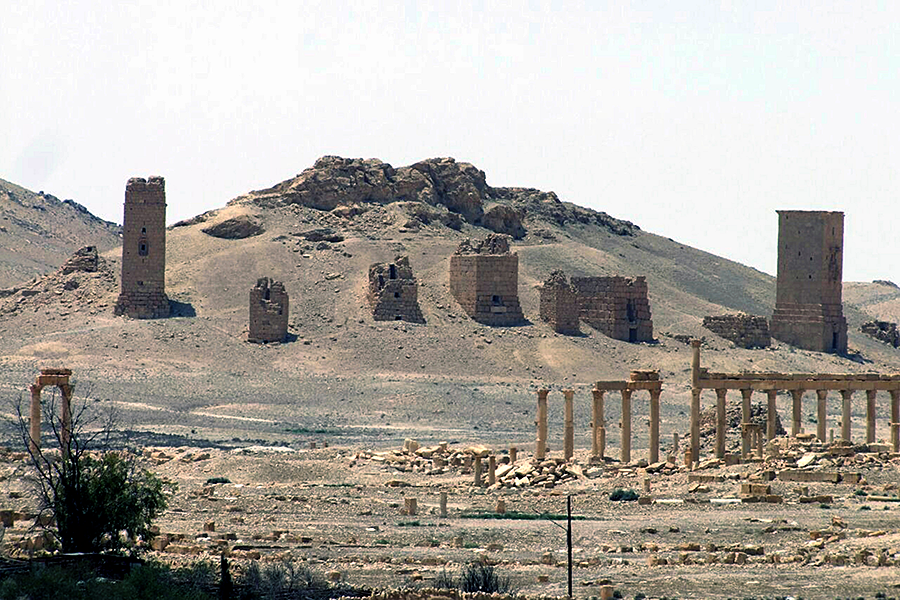Tech world takes on icon-smashing Islamic State with a virtual Palmyra
Loading...
| Istanbul, Turkey
Islamic State jihadists may have destroyed some of ancient Palmyra’s most stunning monuments, but tech gurus and digital archaeologists around the world are determined to bring Syria’s cultural treasure back to life in the virtual world.
In so doing, they also hope to help save the life of a Syrian anti-censorship activist and computer engineer who they fear has been sentenced to death by the regime.
By drawing on architectural plans, data, and photographs collected from contributors across the world, the project hopes to reconstruct what has been destroyed in Palmyra. The UNESCO World Heritage site has been targeted in recent months by IS as part of its systematic destruction of competing cultures’ relics in its self-declared “caliphate.”
“We are not only taking this idea of constructing a new virtual Palmyra as a hard science project,” says Barry Threw, interim director of New Palmyra, the open-source platform dedicated to rebuilding the ancient city. “It is also a community-building project, to get people together around this idea of reconstructing a new virtual site while IS has been actively deleting the culture and history physically.”
Contributors to the project would wave copyrights and put the material in the public domain, allowing anyone to share, modify, and build on the content, including creating derivative works.
One of the attractions of digital archaeology, say proponents, is that it can make monuments like Palmyra’ Bel Temple – which IS militants blew up in August – accessible online.
Mr. Threw, a San Francisco-based artist focusing on experiential technologies, imagines a day when virtual reality headsets are so ubiquitous that people at home can put them on and inhabit a space like Palmyra “without having to get into an airplane or walk into a warzone.”
Some of the necessary tools are immersive and virtual reality technologies, laser scanning, and 3D modeling or printing.
A way of fighting IS
Trideo, a startup company in Argentina, recently used 3D printers to produce a model of the temple. “We were able to reconstruct the whole temple thanks to pre-existing photographs and archives,” says Laurent Rodriguez of Trideo. “It was also a way of showing we are against IS."
Trideo's model, which respected the scale of the ruins, was printed over several hours, one 0.2 mm layer of plastic at a time. The base of the miniature temple was rolled out first, followed by more than three dozen columns, and then the top of the structure.
In France, Yohann Janin of Archeologie Virtuelle, is creating detailed virtual reality versions of the Bel Temple as it stood at the end of the second century, drawing on the scientific publications of German and French archaeologists who explored the site in the 20th century.
“The temple of Bel was an architectural symbol of the mixture of Mediterranean and Eastern cultures,” says Mr. Janin. “The temple’s ruins were well preserved before their destruction.”
The only variation in his virtual reality version, he adds, will be a tribute to peace.
The New Palmyra project grew out of the work of a Damascus-based computer engineer, Bassel Khartabil. The advocate of freedom of expression and open source technologies is now a political prisoner of the Syrian government.
Back in 2005, six years before the Syrian conflict erupted, Mr. Khartabil had set about photographing the archaeological complex of Palmyra in order to virtually reconstruct the site in its ideal form. Military intelligence detained him in 2012. The following year he received the annual Index on Censorship Digital Freedom Award.
Disappeared without a trace
“He really loved Palmyra,” says his wife Noura Ghazi, briefly laughing at the memory of him sleeping next to his eight computers. “But he could not complete this work because the revolution started and he was arrested.”
Ms. Ghazi says her last visits to her husband in Adra Prison on the outskirts of Damascus were tinged with the sorrow of knowing IS was systematically destroying Palmyra and that the ruins' keeper, Khaled Al-Asaad, had been brutally killed.
“This [New Palmyra] project made him happy,” adds Gazi. She says her husband said: “Let’s try to collect everything there is about Palmyra and try to keep it alive with images on the Internet. Let’s protect Syrian memory and identity from the disfiguration underway.”
Khartabil has since disappeared without a trace. There are unconfirmed reports he was transferred to a military Field Court in October that allegedly sentenced him to death. In such courts, closed-door proceedings are the norm. Thirty international and local rights groups are calling for his unconditional release.
The New Palmyra Project, along with Human Rights Watch and the Electronic Frontier Foundation, has helped draw attention to his case.
'It is about all cultural heritage'
Many feel the New Palmyra project could be replicated for other war-ravaged sites in Syria and Iraq, where IS has carved out territory. Amr Al-Azm, an archaeologist and adviser to the project notes that Syria has several other World Heritage Sites and that many parties have destroyed or looted cultural heritage sites, with less fanfare than IS.
“It is not just about Palmyra, it is about all cultural heritage,” says Mr. Al-Azm. “You are basically saying back to anyone who is destroying cultural heritage – ‘Well you can destroy the mortar, you can destroy the bricks, you can destroy the stone, but you cannot erase the memory. We will recreate the memory, no matter how much damage you do.’"
Saving the past is also a way of saving the future, he says, by facilitating Syria’s eventual transition from war to peace.
“Syrians are going to have to reach across this huge divide and find these common denominators, find the things that they still share,” he says. “I think cultural heritage is going to be very important because it has proven itself to be this link, this bridge.”





